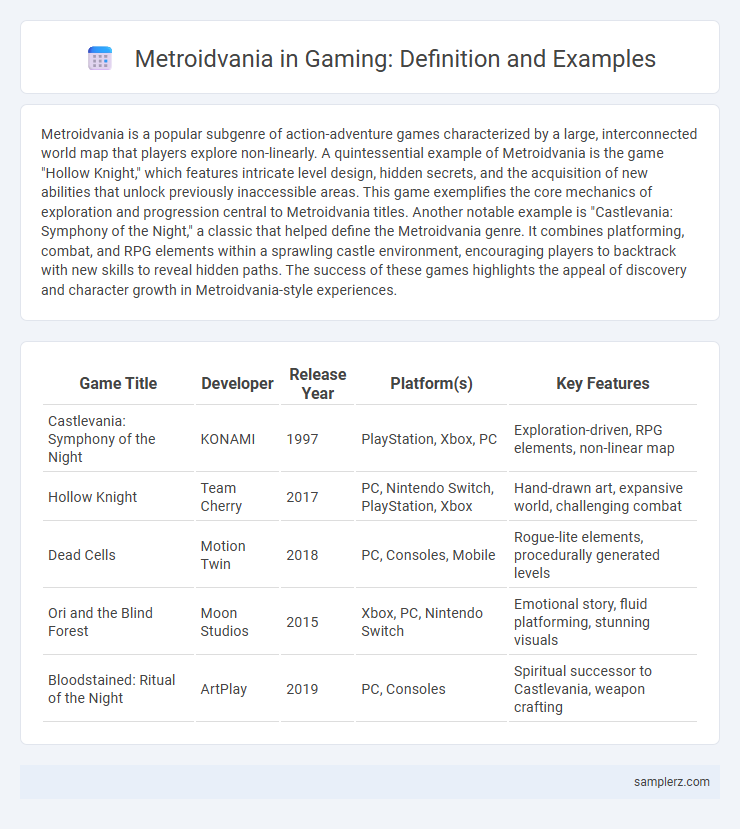Metroidvania is a popular subgenre of action-adventure games characterized by a large, interconnected world map that players explore non-linearly. A quintessential example of Metroidvania is the game "Hollow Knight," which features intricate level design, hidden secrets, and the acquisition of new abilities that unlock previously inaccessible areas. This game exemplifies the core mechanics of exploration and progression central to Metroidvania titles. Another notable example is "Castlevania: Symphony of the Night," a classic that helped define the Metroidvania genre. It combines platforming, combat, and RPG elements within a sprawling castle environment, encouraging players to backtrack with new skills to reveal hidden paths. The success of these games highlights the appeal of discovery and character growth in Metroidvania-style experiences.
Table of Comparison
| Game Title | Developer | Release Year | Platform(s) | Key Features |
|---|---|---|---|---|
| Castlevania: Symphony of the Night | KONAMI | 1997 | PlayStation, Xbox, PC | Exploration-driven, RPG elements, non-linear map |
| Hollow Knight | Team Cherry | 2017 | PC, Nintendo Switch, PlayStation, Xbox | Hand-drawn art, expansive world, challenging combat |
| Dead Cells | Motion Twin | 2018 | PC, Consoles, Mobile | Rogue-lite elements, procedurally generated levels |
| Ori and the Blind Forest | Moon Studios | 2015 | Xbox, PC, Nintendo Switch | Emotional story, fluid platforming, stunning visuals |
| Bloodstained: Ritual of the Night | ArtPlay | 2019 | PC, Consoles | Spiritual successor to Castlevania, weapon crafting |
Defining Metroidvania: Key Features and Origins
Metroidvania games combine exploration, platforming, and nonlinear progression, characterized by interconnected maps and ability-based access to new areas. Originating from iconic titles like Metroid (1986) and Castlevania: Symphony of the Night (1997), the genre emphasizes backtracking and skill upgrades to unlock hidden secrets. Key features include intricate level design, character progression, and a cohesive world that encourages discovery and mastery.
Classic Metroidvania Titles That Shaped the Genre
Classic Metroidvania titles such as "Castlevania: Symphony of the Night" and "Super Metroid" established core gameplay elements like non-linear exploration, ability-based progression, and interconnected maps. These games influenced numerous modern titles by emphasizing map discovery, character upgrades, and backtracking mechanics. Their impact is evident in contemporary metroidvania games like "Hollow Knight" and "Ori and the Blind Forest," which build upon these foundational design principles.
Modern Innovations in Metroidvania Games
Modern Metroidvania games like "Hollow Knight: Silksong" integrate intricate world-building with seamless movement mechanics, enhancing player immersion. Titles such as "Ori and the Will of the Wisps" utilize advanced visual storytelling and dynamic environments to deepen narrative engagement. These innovations underscore how contemporary Metroidvania designs blend traditional exploration with cutting-edge gameplay elements.
Iconic Metroidvania Protagonists and Characters
Iconic Metroidvania protagonists like Samus Aran from the Metroid series and Alucard from Castlevania: Symphony of the Night define the genre with their unique abilities and intricate backstories. Characters such as Ori from Ori and the Blind Forest and Shovel Knight also exemplify the exploration and progression mechanics central to Metroidvania games. These protagonists often feature customizable skills and weapons that unlock new areas, driving the hallmark non-linear gameplay experience.
Indie Success Stories in the Metroidvania Scene
Hollow Knight by Team Cherry stands as a hallmark of indie success in the Metroidvania genre, praised for its intricate level design, challenging combat, and atmospheric storytelling. Ori and the Blind Forest, developed by Moon Studios, combines stunning visuals with emotional narrative, setting a high standard for indie Metroidvania games. Dead Cells from Motion Twin revolutionizes the genre with roguelike elements, offering procedural generation and fast-paced gameplay that have captivated a broad player base.
Level Design and Exploration in Metroidvania Games
Metroidvania games excel in level design by creating intricate, interconnected maps that encourage deep exploration and backtracking with newly acquired abilities. This design promotes player engagement through non-linear progression, rewarding curiosity with hidden paths, secret upgrades, and evolving challenges. The seamless integration of exploration mechanics and environmental storytelling defines the genre's immersive world-building experience.
Popular Metroidvania Franchises to Try
Popular Metroidvania franchises to try include "Castlevania," renowned for its gothic exploration and intricate level design, and "Hollow Knight," praised for its deep lore and challenging combat. "Ori and the Blind Forest" offers a visually stunning experience with fluid platforming mechanics, while "Axiom Verge" delivers a sci-fi twist with complex weapon systems and non-linear progression. These titles exemplify the core elements of Metroidvania games: interconnected worlds, ability-based exploration, and immersive storytelling.
Metroidvania Elements in Non-Traditional Games
Metroidvania elements such as interconnected maps, ability-based progression, and exploration-driven gameplay are increasingly integrated into non-traditional games like action RPGs and platformer hybrids. Titles like Hollow Knight and Ori and the Blind Forest exemplify this trend by blending Metroidvania mechanics with unique art styles and narrative depth, expanding the genre's influence beyond classic conventions. These games emphasize skill acquisition and backtracking to unlock new areas, creating immersive experiences that appeal to a broad gaming audience.
The Influence of Metroidvania on Game Development
Metroidvania games like "Hollow Knight" and "Ori and the Blind Forest" have significantly influenced game development by emphasizing exploration, non-linear progression, and interconnected world design. Developers adopt intricate level layouts combined with ability-based unlocks to create immersive player experiences, encouraging backtracking and discovery. This genre's design principles inspire innovation in gameplay mechanics, narrative integration, and world-building across various gaming genres.
Upcoming Metroidvania Releases to Watch
Upcoming Metroidvania releases such as "Hollow Knight: Silksong" and "Record of Lodoss War: Deedlit in Wonder Labyrinth" promise to expand the genre with intricate level design and challenging gameplay. These titles feature non-linear exploration, skill upgrades, and rich storytelling elements that define metroidvania games. Players can anticipate diverse environments and new mechanics that enhance the genre's signature blend of action and exploration.

example of metroidvania in gaming Infographic
 samplerz.com
samplerz.com